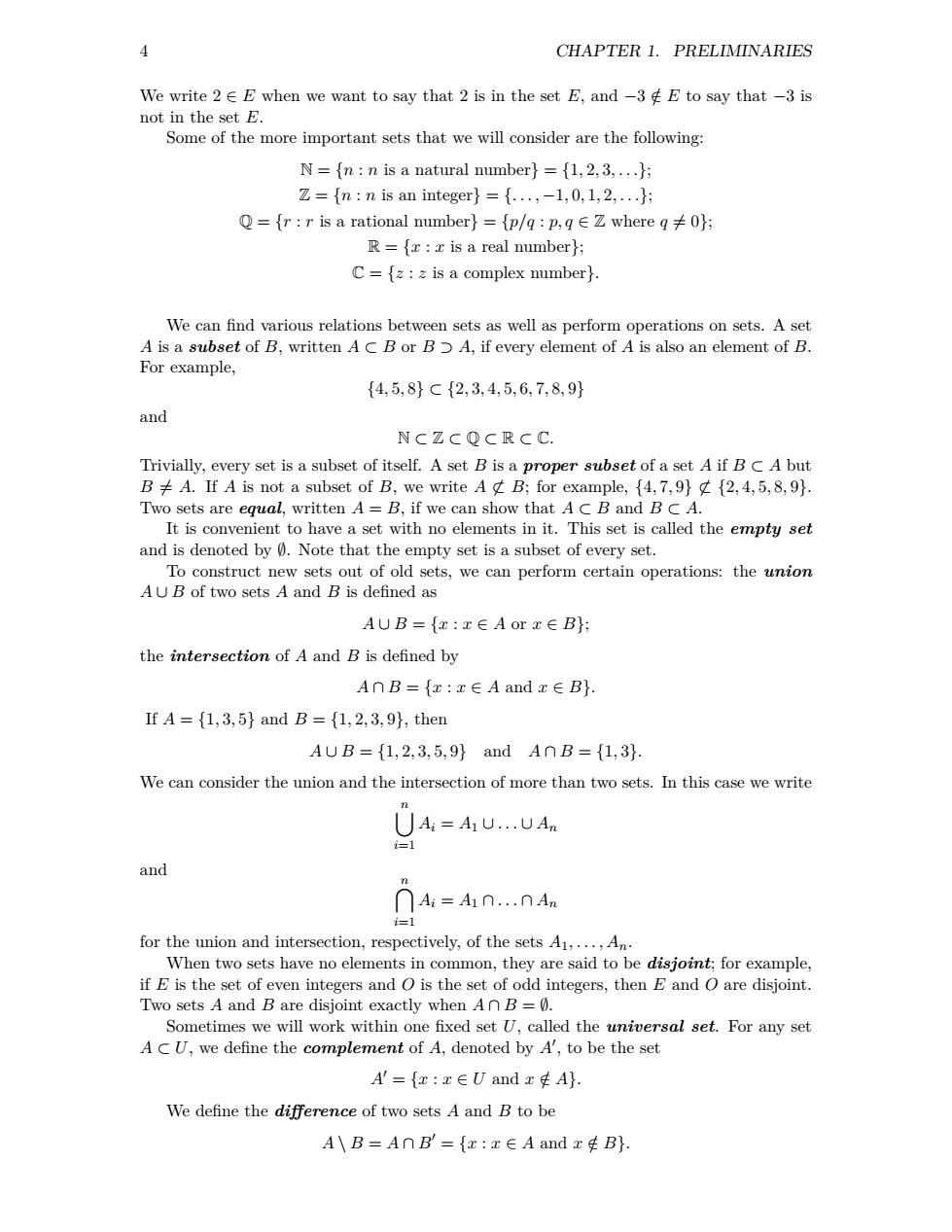正在加载图片...

CHAPTER 1.PRELIMINARIES We write 2 EE when we want to say that 2 is in the set E,and-3E to say that -3 is not in the set E. Some of the more important sets that we will consider are the following: N={nn is a natural number}={1,2,3,...}; Z={nn is an integer}={...,-1,0,1,2,...}; Q={rr is a rational number}=fp/q:p,gZ where 0); R=fx:z is a real number}; C=fz:z is a complex number. We can find various relations between sets as well as perform operations on sets.A set A is a subset of B,written AC B or B A,if every element of A is also an element of B. For example, {4,5,8}C{2,3,4,5,6,7,8,9} and NCZCQCRCC. Trivially,every set is a subset of itself.A set B is a proper subset of a set A if B C A but B A.If A is not a subset of B,we write A B;for example,(4,7,9}d (2,4,5,8,9}. Two sets are equal,written A B,if we can show that A C B and B C A. It is convenient to have a set with no elements in it.This set is called the empty set and is denoted by 0.Note that the empty set is a subset of every set. To construct new sets out of old sets,we can perform certain operations:the union AUB of two sets A and B is defined as AUB={x:x∈Aorx∈B}: the intersection of A and B is defined by AnB={x:x∈A and x∈B}: IfA={1,3,5}andB={1,2,3,9},then AUB={1,2,3,5,9}andA∩B={1,3} We can consider the union and the intersection of more than two sets.In this case we write UAi=A1 U...UAn i=1 and ∩A=An..nAn i=1 for the union and intersection,respectively,of the sets A1,...,An. When two sets have no elements in common,they are said to be disjoint;for example, if E is the set of even integers and O is the set of odd integers,then E and O are disjoint. Two sets A and B are disjoint exactly when An B=0. Sometimes we will work within one fixed set U,called the universal set.For any set A CU,we define the complement of A,denoted by A',to be the set A'={x:x∈U and x A}: We define the difference of two sets A and B to be A\B=AnB={x:x∈A and z年B}4 CHAPTER 1. PRELIMINARIES We write 2 ∈ E when we want to say that 2 is in the set E, and −3 /∈ E to say that −3 is not in the set E. Some of the more important sets that we will consider are the following: N = {n : n is a natural number} = {1, 2, 3, . . .}; Z = {n : n is an integer} = {. . . , −1, 0, 1, 2, . . .}; Q = {r : r is a rational number} = {p/q : p, q ∈ Z where q ̸= 0}; R = {x : x is a real number}; C = {z : z is a complex number}. We can find various relations between sets as well as perform operations on sets. A set A is a subset of B, written A ⊂ B or B ⊃ A, if every element of A is also an element of B. For example, {4, 5, 8} ⊂ {2, 3, 4, 5, 6, 7, 8, 9} and N ⊂ Z ⊂ Q ⊂ R ⊂ C. Trivially, every set is a subset of itself. A set B is a proper subset of a set A if B ⊂ A but B ̸= A. If A is not a subset of B, we write A ̸⊂ B; for example, {4, 7, 9} ̸⊂ {2, 4, 5, 8, 9}. Two sets are equal, written A = B, if we can show that A ⊂ B and B ⊂ A. It is convenient to have a set with no elements in it. This set is called the empty set and is denoted by ∅. Note that the empty set is a subset of every set. To construct new sets out of old sets, we can perform certain operations: the union A ∪ B of two sets A and B is defined as A ∪ B = {x : x ∈ A or x ∈ B}; the intersection of A and B is defined by A ∩ B = {x : x ∈ A and x ∈ B}. If A = {1, 3, 5} and B = {1, 2, 3, 9}, then A ∪ B = {1, 2, 3, 5, 9} and A ∩ B = {1, 3}. We can consider the union and the intersection of more than two sets. In this case we write ∪n i=1 Ai = A1 ∪ . . . ∪ An and ∩n i=1 Ai = A1 ∩ . . . ∩ An for the union and intersection, respectively, of the sets A1, . . . , An. When two sets have no elements in common, they are said to be disjoint; for example, if E is the set of even integers and O is the set of odd integers, then E and O are disjoint. Two sets A and B are disjoint exactly when A ∩ B = ∅. Sometimes we will work within one fixed set U, called the universal set. For any set A ⊂ U, we define the complement of A, denoted by A′ , to be the set A ′ = {x : x ∈ U and x ∈/ A}. We define the difference of two sets A and B to be A \ B = A ∩ B ′ = {x : x ∈ A and x ∈/ B}